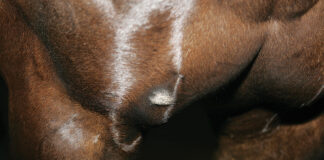Cold weather poses unique challenges when it comes to keeping horses clean—challenges we don’t face during warm weather. Lower temperatures and horses’ thick, winter coats all make the routine bath difficult. Although nothing beats a warm, soapy bath, alternative tactics for cleaning your horse in cold weather can be applied with almost the same results.
Bathing in Winter
You can bathe your horse when the temperature is above freezing if you have a wash area with hot water, but you’ll still need to exercise certain caution when bathing a horse when the temperature is below 50. This is especially true if he has a thick, winter coat. Be as efficient as possible when washing him. Use a minimal amount of soap and work quickly to get him washed and rinsed. As soon as you scrape the water off him, rub him briskly with a thick, dry towel. This serves several purposes: Toweling removes additional moisture from the coat. It picks up any additional dirt and/or soap that may have been left under the longer hair. It lifts the hair, which enables it to dry more quickly. Finally, toweling increases the horse’s circulation under the skin, which will warm him. Once you finish toweling him, cover him with a wool or fleece cooler and put him in the sun, in his stall or someplace protected from drafts until he is dry.
Hot-Towel Treatment
A hot-towel bath is a workout for you, but it will get your horse surprisingly clean. First, thoroughly groom your horse to remove any caked-on mud and dirt. Next, collect an assortment of medium-sized towels. Fill a 5-gallon bucket with hot water. Cold water will suffice if that’s what you have access to. Dunk a towel and then wring out as much of the water as you can. Start on one area of your horse, such as his neck, and rub the hair briskly. Rinse out the towel and repeat, working over small sections at a time. Once you finish an area, take a dry towel and rub the hair the same way. Your last stroke should be against the direction the hair grows so that it is standing up. This will help it to dry more quickly. As soon as you are finished with his body, cover him with a cooler. This will help keep from getting chilled, and he will also dry faster. Once he is dry, spray his coat with a coat conditioner to moisturize the hair and help repel dust, and then brush him.
Spot Cleaning
You can give your horse a sponge bath using the same techniques used for the hot-towel bath. The best sponge to use is a large, coarse one. If your horse has worked up a good sweat, the sweaty areas may foam as you rub them. If they do, you will need to frequently rinse out the sponge and continue scrubbing the area until it no longer foams. Once you finish each area, rub the area with a dry towel and leave the hair standing up to dry quickly.
Horses are actually more tolerant of extreme temperatures than humans are. You can hose off your horse with cold water from the elbows down without causing any discomfort as long as you keep him sheltered until his legs are dry. If fact, if your horse is still sweating post-exercise, cold hosing his legs will actually help him cool down faster. To get your horse acclimated to cold water, start at the bottom of his legs and slowly work your way up. By the time you reach the top of his legs, he will be accustomed to the water’s temperature and you can wash his girth area and between his front and back legs without worrying about him getting chilled. You can also wash your horse’s tail in cold water without distressing him, provided you wash below the tailbone only. Use a sponge for the top part of his tail.
As much of a challenge as it can be to keep your horse clean during the cold winter months, it’s worth the extra effort. Your horse may still be as wooly as a mammoth, but he will be clean and comfortable in his fur coat.






It would seem that only the first method actually cleans the horse. The other methods just clean off the outer layers, right?
Great tips though. Maybe my horse will be a little cleaner.
very useful
Very hard to keep my horses clean. They prefer to wear a dirt coat!!